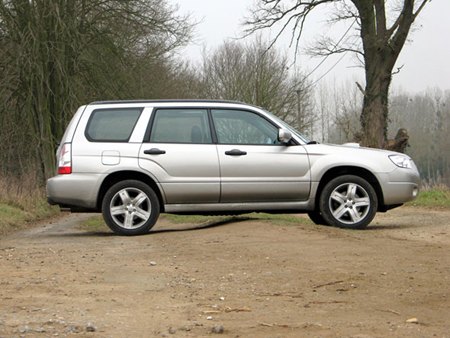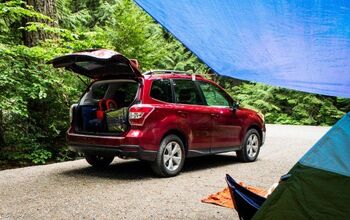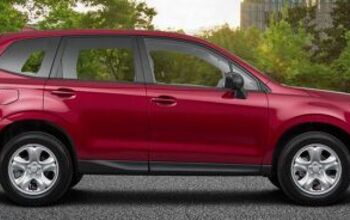Subaru Forester 2.5 XT Review

Back in the day, Subaru couldn’t afford to build a new vehicle to compete in the smoking hot SUV sector. So they took an Impreza, jacked it up a couple of inches, raised the roof and reskinned the body. The result was a hit, and helped define the modern small CUV. Ten years later, the Subaru Forester battles on, facing its third gen competitors (Honda CRV and Toyota RAV4) with nothing more than a few questionable sheet metal creases, a spiffed up interior, and the addition of the turbocharged XT model. The CUV pool’s getting more crowded by the day, and, compared to the Subie’s well-worn REI fleece, the competition looks like its wearing designer duds. We checked out an XT to answer a simple question: is it a classic or a relic?
The basic package hasn’t changed, nor should it. The Popemobile proportions (tall windshield and high roof) are a motorized mitzvah for tall drivers. While the result flies in the face of history– when Chrysler President K. T. Keller insisted that tall men should be able to wear fedoras in his cars, he almost killed the company—the resulting visibility is virtually unparalleled. Swoopy cars, low angle windshields and obese pillars be damned; Forester owners want to see who they’re cutting off where they’re parking.
The Forester’s boxy exterior has suffered a reverse face lift (a face drop?): folds and lines have replaced youthful smoothness. Or is it just aging naturally? Something short, ugly and Russian comes to mind; either a Lada Niva or an old babushka. Who cares; the Forester was born ugly, but it remains true to its mother’s wise admonition: “It’s what’s inside that counts.”
And mother’s advice has been well heeded. Compared to lesser Foresters of yore, stepping into the ’07 XT is like visiting your favorite old diner after it’s been turned into the Trattoria de Toscano. Subaru’s replaced the old fabric booth with heated leather seats that wouldn’t be out of place in a German motor. The steering wheel is like putting on expensive leather gloves. The instruments are clean and classic; no trendy gimmicks. The aluminesque center panel is a la mode, but the controls are logical and obvious. Workmanship: a solid B+. A good thing too, because with that lovely big sky-light overhead, flaws have no place to hide.
Unfortunately, there’s one less-then-salubrious carryover: rear leg room. The Forester’s second row is as ergonomically challenged as the third row of a transplant CUV. My teenage son’s solution: stretch his feet out between the front seats. How safe (and smelly) is that?
The Forrester XT’s inner beauty really shines in the engine compartment. The 2.5 liter flat four cranks out 224 horsepower and 226 ft/lbs of torque, and with its inherent nigh-perfect balance, it always stays cool and smooth. It lets you know it’s there with that turbo-whistle, but it’s never objectionable, unless Lexus is your benchmark.
Like most turbos, it’s a little coy at low revs, but once past 3000rpm the sex bomb explodes all the way to its 6500rpm redline. With AWD keeping the XT’s footwear firmly in contact with the pavement, redlining first gear is like high school hot-rod antics for grown-ups: all the fun, but none of the attention-grabbing tell-tale of burning rubber. Second gear takes you to 60mph in just 5.3 seconds. Keep rowing and the quarter mile arrives in 13.8. There’s more bang on offer than you’ll find at a percussionist’s convention.
The XT’s traction, ride and handling are up to the accelerative challenge. The all-season 17” rubber sing their surrender to lateral g-forces too early, but that’s a fair trade-off for getting to the ski lodge. With its low center of gravity (a la boxer engine), SUV vertigo is noticeable by its absence. Whether throwing the machine sideways on blind-corner gravel logging roads, bumping down a rocky path to a hiking trail, making high speed runs on deserted desert roads or barreling through snow, ice, wind and rain; the XT is always supple, accomplished and confident.
When cruising the freeway, the XT’s low gearing is a lot less helpful. I kept reaching out to the shifter in hopes that it had miraculously grown a sixth gear. At 75mph or so, an extra cog would put the revs right at the intersection of turbo-plateau and turbo-boost, in that preferred state of restful alertness rather than futile restlessness. Sigh.
After the styling miscalculation with the B9 Tribeca, trepidation as to what Subaru will throw our way with the next gen Forester is warranted. They seem to be chasing an Audi/Volvoesque styling direction, with highly uneven results. The current Forester may well end up being the last in a long lineage of Subaru funky boxes. Buy or wait? My take: better the devil you know.

More by Paul Niedermeyer
Latest Car Reviews
Read moreLatest Product Reviews
Read moreRecent Comments
- Jeff Self driving cars are not ready for prime time.
- Lichtronamo Watch as the non-us based automakers shift more production to Mexico in the future.
- 28-Cars-Later " Electrek recently dug around in Tesla’s online parts catalog and found that the windshield costs a whopping $1,900 to replace.To be fair, that’s around what a Mercedes S-Class or Rivian windshield costs, but the Tesla’s glass is unique because of its shape. It’s also worth noting that most insurance plans have glass replacement options that can make the repair a low- or zero-cost issue. "Now I understand why my insurance is so high despite no claims for years and about 7,500 annual miles between three cars.
- AMcA My theory is that that when the Big 3 gave away the store to the UAW in the last contract, there was a side deal in which the UAW promised to go after the non-organized transplant plants. Even the UAW understands that if the wage differential gets too high it's gonna kill the golden goose.
- MKizzy Why else does range matter? Because in the EV advocate's dream scenario of a post-ICE future, the average multi-car household will find itself with more EVs in their garages and driveways than places to plug them in or the capacity to charge then all at once without significant electrical upgrades. Unless each vehicle has enough range to allow for multiple days without plugging in, fighting over charging access in multi-EV households will be right up there with finances for causes of domestic strife.






































Comments
Join the conversation
just FYI, the 2.5s were underrated. the old 2.0s dyno at around 175WHP, whereas the stock 2.5 dynos at 190+ WHP.
Long term report... My wife and I bought our first brand new Subaru; a 2005 Forester XT and loved it. For the first 100,000 miles the vehicle was perfect. Quick, reliable, handled incredibly well and seemed to do everything right. Shortly after the 100,000 mark, everything started to break and become insanely expensive to fix. The sunroof cable attaching guides were apparently made of cheap plastic and broke. The cost of replacing the entire sunroof frame assembly was measured in thousands of dollars - hence we didn't fix it. The car went through two radiators, which are primarily made of plastic. The plastic driver's seat trim kept getting caught on our clothing and would get torn off. I finally secured it to the seat frame with a sheet metal screw, which fixed the problem. Then the serious stuff started... The turbo housing cracked and the cylinder heads cracked. That repair was a whopping $7000! The idler pulley failed. The new cam belt kept skipping a tooth causing engine lights and a "safe mode" driving experience. Latest is a report that the bottom end of the motor is now shot at 155,000 miles? Minimum cost to fix this with a low mileage used engine is $6000. We realize cars don't last forever, but our last 1995 Mitsubishi Galant was still going strong after 367,000 miles, requiring only basic maintenance. In today's world, 150,000+ miles is nothing - unless you own a Subaru. This has been by far the most expensive car we've ever owned, when you combine the ~$28,000 purchase price and the $15,000 in repair costs over the past 7 years. Sadly when we purchase our next car, it will not be a Subaru...